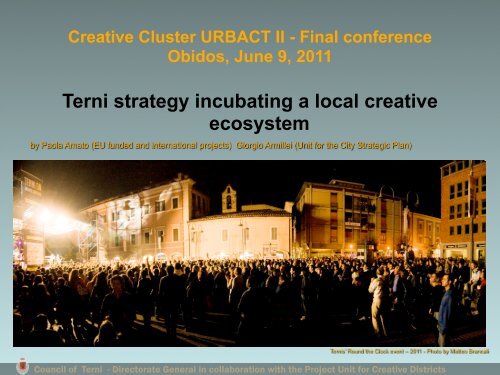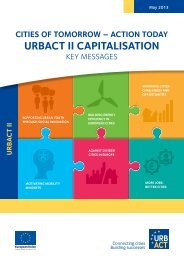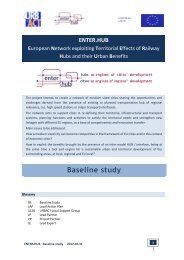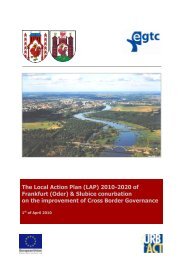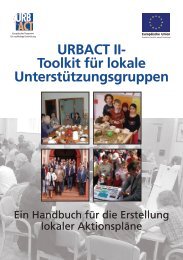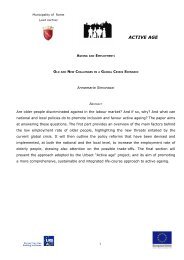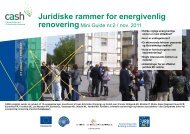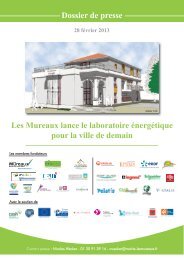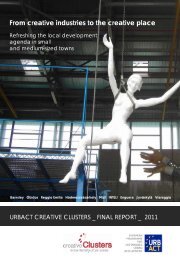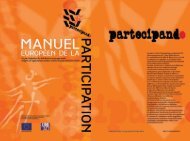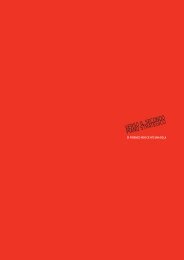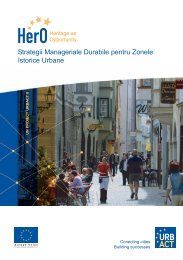Terni Strategy Incubating a Local Creative Ecosystem - Urbact
Terni Strategy Incubating a Local Creative Ecosystem - Urbact
Terni Strategy Incubating a Local Creative Ecosystem - Urbact
Create successful ePaper yourself
Turn your PDF publications into a flip-book with our unique Google optimized e-Paper software.
<strong>Creative</strong> Cluster URBACT II - Final conference<br />
Obidos, June 9, 2011<br />
<strong>Terni</strong> strategy incubating a local creative<br />
ecosystem<br />
by Paola Amato (EU funded and international projects) Giorgio Armillei (Unit for the City Strategic Plan)<br />
<strong>Terni</strong>s’ Round the Clock event – 2011 - Photo by Matteo Brancali<br />
Council of <strong>Terni</strong> - Directorate General in collaboration with the Project Unit for <strong>Creative</strong> Districts
<strong>Terni</strong> at the cross-road of the overall dynamics of central Italy<br />
ROME<br />
TERNI<br />
• Umbria Region (Perugia, capital city); Total population:<br />
about 850.000 inhab; 70% of<br />
Umbria’s areas are classified as intermediate rural areas<br />
and only 30% and mountain<br />
areas;<br />
• Famous cities within the Region: Assisi, Gubbio,<br />
Orvieto, Spoleto, Perugia.<br />
• 2 main provinces and 2 major cities: <strong>Terni</strong> and<br />
Perugia.<br />
Extremely diffuse urbanisation with extensive green<br />
and forestry areas, beautiful sceneries; urban centres<br />
developed around old medieval<br />
cores still well preserved;<br />
• 90% of the Umbria’s 92 local communities have a<br />
population of 3000 to 20.000 inhab.<br />
Sorce (top left):<br />
- Disegno StrategicoTerritoriale by the Region Umbria (2010);<br />
- OP ERDF 2007-2013 . Region Umbria<br />
Umbria, <strong>Terni</strong><br />
Port of<br />
CIVITAVECCHIA<br />
City of <strong>Terni</strong><br />
-140.000 inhabitants<br />
- Surface: 211,90 Km 2<br />
- Urban density: 532/km 2<br />
Source (top right): <strong>Terni</strong>’s Territorial Strategic Plan (2010-2019)<br />
– Overview of the main transport, communication<br />
infrastructures and European corridors. In the scheme <strong>Terni</strong><br />
is placed in the inter-cross and is part of the dynamics<br />
of “Central Italy” , an area with not legal boudary grouping<br />
Lazio, Marches, Tuscany and Emilia Romagna. Its<br />
dynamics is largely affected by the capital city, Rome.<br />
<strong>Terni</strong> – Overall dynamics and territorial characteristics Comune di <strong>Terni</strong><br />
TERNI<br />
ROME<br />
Port of<br />
ANCONA
Images from <strong>Terni</strong>’s SPA in the late 1800s.<br />
Industries of national strategic importnace<br />
located along the Nera River<br />
LEGACY OF THE PAST: Strength of tomorrow<br />
<strong>Terni</strong>’s main centre massively bombed in WW2<br />
remained largely blighted and scarred up to early 1990s<br />
LEGACY OF THE PAST<br />
STREGTH OF TODAY AND TOMORROW<br />
Galleto’s Hydroplant built in the 1800s.<br />
The area housed the old electrochemical<br />
plants<br />
Marmore’s waterfall<br />
The tallest artificial falls<br />
in Europe and today Italy’s<br />
6th tourist attraction<br />
<strong>Terni</strong>’s main central space<br />
<strong>Terni</strong> : legacy of the past,stregth for tomorrow Comune di <strong>Terni</strong>
LEGACY OF THE PAST, Strength of tomorrow<br />
INDUSTRIAL DECLINE:<br />
•<strong>Terni</strong> maintains one of the<br />
oldest and rich asset of<br />
industrial archeology both<br />
in the city centre and along<br />
the River Nera and Marmore<br />
Waterfall. This last trajectory<br />
was hugely exploited by the<br />
Romans and by the Papal<br />
State .In mid 1800s it housed<br />
industrial activities of national<br />
strategic importance (Steel,<br />
Hydroplants, electric plants,<br />
chemical factories);<br />
•Up until late 1990s the city<br />
still borne scars from the<br />
WW2 bombing affecting<br />
central areas with “ghost<br />
districts” and “urban<br />
voids”;<br />
<strong>Terni</strong> : legacy of the past, strength for tomorrow Comune di <strong>Terni</strong>
Reconverting and diversifying urban functions.. rethinking the<br />
future of the city<br />
1990s URBAN REGENERATION AND TERNI INDUSTRIAL ARCHEOLOGY<br />
• Acquisition of industrial dismissed areas and old industrial archeological sites.<br />
• Experiments of complex urban sustainable plans and regeneration programmes.<br />
• Favoring PPP such as project financing, paving the way for Jessica<br />
Leasure and professional spots along the river Nera<br />
Papigno’s film sets<br />
Transformation and<br />
investments<br />
along River Nera<br />
and Marmore waterfalls<br />
An exhibition hall of the new museums<br />
Urban renovation<br />
and new culture attractors<br />
The CMM audiovisual&digital centre<br />
A new city centre<br />
The CAOS Multiculture Centre<br />
The new Multimedia library<br />
<strong>Terni</strong> : Reconverting and diversifying urban functions Comune di <strong>Terni</strong>
Main Culture urban divers<br />
• Major experiments driven by huge public (ERDF, National bids,<br />
regional and Council’s sources), and PPP investments in urban<br />
regeneration and restoration were carried out.<br />
Among the main projects<br />
• Multimedia and digital centre (CMM and Mr Rambaldi’s school of<br />
film animation);<br />
• Multi-culture centre (CAOS);<br />
• Multimedia Library (BCT) Centre of Social Integration Activities;<br />
• High Education and Resarch Centres in advanced studies<br />
(innovative materials, nano-technology; stem cell research);<br />
• Papigno film set (Benigni’s awarded “La Vita è Bella”);<br />
• Innovative Urban regeneration Plans of the areas along River Nera;<br />
<strong>Terni</strong> : main culture drivers Comune di <strong>Terni</strong>
The 3 major pillars of <strong>Terni</strong>’s policies and<br />
investments in the field of culture<br />
• Late 1980s (project idea) mid 1990s – early 2000 (realization)<br />
<strong>Creative</strong> enterprises<br />
(multimedia, audiovisual-<br />
CMM, Papigno)<br />
CAOS + new museums<br />
focused on performing arts<br />
(contemporary performance)<br />
Education and labs<br />
Multimedia library<br />
public library based on the concept of idea store<br />
Life Long Learning<br />
Edutainment-<br />
Promotion of reading (all<br />
ages esp. preschool)<br />
<strong>Terni</strong> : main pillars of culture development Comune di <strong>Terni</strong>
OP RDF – Priority: Sustainable<br />
urban construction<br />
7.5 Mil Euros + 3.5 Council funds<br />
Culture<br />
2.2 Mil Euros<br />
Restoration and urban redesign<br />
(including Wi-Fi)<br />
Multimedia<br />
Library<br />
Città Giardino<br />
CAOS
Mr Rambaldi’s animation lab<br />
Multimedia and audiovisual centre-CMM<br />
<strong>Terni</strong> : CMM Comune di <strong>Terni</strong>
Papigno Filming set<br />
<strong>Terni</strong> : Papigno’s filiming set Comune di <strong>Terni</strong>
Multimedia Library - Edutainment<br />
<strong>Terni</strong> –Multimedia Library Comune di <strong>Terni</strong>
Multimedia Library<br />
<strong>Terni</strong> –Multimedia Library Comune di <strong>Terni</strong>
The CAOS is the city’s lively multiculture centre where<br />
once was an old chemical industry dated back to the Papal state in late<br />
1700s. It was completely restored by the Council now housing a<br />
museum, permanent exhibistion halls, a theatre, cafe and other<br />
amenities. CAOS holds annually and on a regual basis a host of cultural<br />
events ranging fron debates, conferences, didactic labs and eminet<br />
exhibition the likes of dedicated to “Piermatteo of Amelia” (Author of the<br />
lost paining of the Cappella Sistina). A major event attracting theatre<br />
lovers and artists from all over Europe and beyond is the Esterni<br />
Festival: focused primary on avant guard theater such event has<br />
run for many years.<br />
CAOS is run by a private company , whose activity was also cited as a<br />
best practice by a recent position paper (2009) produced in the<br />
framework of the structural dialogue within the “Access to Culture”<br />
platform established by the European Commission – DG Culture<br />
The CAOS today<br />
<strong>Terni</strong> – Overall dynamics and territorial characteristics Comune di <strong>Terni</strong>
Another…. CAOS<br />
<strong>Terni</strong> –CAOS Comune di <strong>Terni</strong>
The experiments of culture districts<br />
Culture Districts – Paving the way to the<br />
Città Giardino experiment<br />
• Culture District is a general approach and a a linchpin<br />
action area of the Council’s strategic Plan (2012-2020), a<br />
document aimed to better engage local politicians and<br />
decision makers as well as the Councils' overall organisation<br />
and all stakeholders to share a new vision of the city;<br />
• Culture District approach aims at capitalising on culture<br />
as a main driver of development and at creating durable<br />
growth;<br />
• Borne out of the lesson learned and potential of the<br />
City’s past experimenting in PPP (See EIB JESSICA<br />
Report for Italy) especially in the field of urban<br />
regeneration;<br />
• Placing at the centre tow major culture “drivers”: CAOS<br />
Multiculture Centre and the Council’s multimedia library<br />
(BTC) both vibrant poles of the city culture dynamism and<br />
attractors for the city’s youth;<br />
• It stretches from the Città Giardino District to part of the city<br />
centre;<br />
• It is a bottom up approach that involves the CAOS’s<br />
<strong>Terni</strong> – The Strategic plan and the città Giardino experiment Comune di Tern
Città Giardino-<strong>Creative</strong> Quarter<br />
Lines of action<br />
• Urban negotiating schemes;<br />
• New management schemes for<br />
public spaces and buildings;<br />
• Regional incentives on creative<br />
enterprises (OP ERDF);<br />
• Free WI-FI access and web 2.0<br />
services (aimed at creative<br />
enterprises);<br />
• Communication<br />
• Increase synergies among cultural<br />
assets (CAOS, Multimedia<br />
Library);<br />
• Favoring partnership and<br />
collaboration with local<br />
associations (Group of Young<br />
Architect), enterprises (CAOS),<br />
University<br />
<strong>Terni</strong> –Main lines of action Comune di Tern
Easier access<br />
to bank credit<br />
Out<br />
Increase young<br />
residents<br />
Public subsiding<br />
or funding<br />
ORDER OF THE CAOS…..<br />
More job offer<br />
/prospect<br />
in the district<br />
Create new<br />
enterprises<br />
Objective tree - Città Giardino<br />
Public<br />
awareness<br />
Funding<br />
(private/public)<br />
Cultural and<br />
physical<br />
regeneration<br />
of the district<br />
Regeneration plan<br />
in place<br />
Political<br />
Consensus<br />
(public private<br />
negotiation)<br />
Regeneration<br />
strategy<br />
Awareness<br />
on the problem<br />
Regenerated<br />
Buildings<br />
and public<br />
spaces<br />
Increased<br />
competences<br />
Deployed specialist<br />
training<br />
Adequate<br />
maintenance<br />
High<br />
cost of traditional<br />
maintenance<br />
Alternatives solutions<br />
and public<br />
participation<br />
Higher in the<br />
agenda<br />
of local politicians<br />
Generated value<br />
chain and growth<br />
by CAOS<br />
as a long<br />
term driver<br />
Festivals and events<br />
attracting external<br />
demand<br />
and investments<br />
New culture<br />
attractive<br />
strategy<br />
Increased small<br />
retailing<br />
specialist shops/<br />
commercial services<br />
Shared opinion by<br />
decision makers<br />
Interest on the part<br />
of local and<br />
extra-regional<br />
communities<br />
Increased services<br />
for artists to promote<br />
diversified<br />
events<br />
Increased in quality<br />
products/services<br />
not offered by<br />
large retailers<br />
Out<br />
Strong and effective<br />
promotion strategy<br />
and stakeholder<br />
analysis<br />
<strong>Terni</strong> – The order of the CAOS Comune di <strong>Terni</strong>
The Città Giardino - Think Town <strong>Terni</strong><br />
and FestArch Lab by Abitare<br />
1st and 2nd Festivals of Architecture<br />
(Oct. 2010-June 2011)<br />
Displacing architecture<br />
works, activating participatory<br />
labs with local residents and<br />
interesting debates/conference<br />
with eminent experts also from other<br />
European countries. The event was<br />
promoted by <strong>Terni</strong>’s section of the<br />
National Association of Young<br />
TEMPORARY ARCHITECTURE > 2A+P/A<br />
(ITA) How meet in town...<br />
<strong>Terni</strong> – Group of Young Architects in <strong>Terni</strong> (GATR) Comune di <strong>Terni</strong>
What we found useful in <strong>Creative</strong><br />
Clusters<br />
• <strong>Creative</strong> Clusters has proved an interesting lab for<br />
medium and small cities trying to strive models of city<br />
development based on culture industry<br />
• The base line analysis and the systematic<br />
coordination of results produced by project<br />
leader of <strong>Creative</strong> Clusters in particular have<br />
proved a valuable and powerful logical frame that might also<br />
set into the right perspective both potential or limits of (<strong>Terni</strong>)<br />
Council’s action since success of development depends on<br />
variable factors often in control of diversified decision making<br />
levels.


